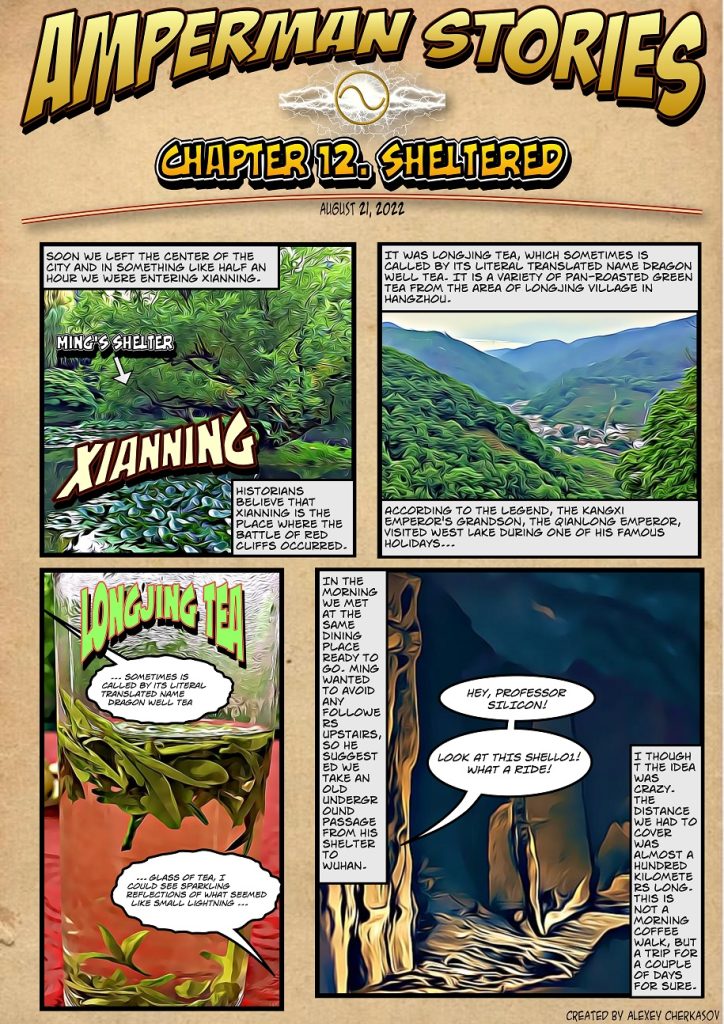Soon we left the center of the city and in something like half an hour we were entering Xianning. Professor Ming said that despite its small size compared to Wuhan the importance of this city in the history of China is tremendous. Historians believe that Xianning is the place where the Battle of Red Cliffs occurred.
The Battle of Red Cliffs, also known as the Battle of Chibi, was a decisive naval battle in the winter of AD 208–209 at the end of the Han dynasty, about twelve years prior to the beginning of the Three Kingdoms period in Chinese history. The Three Kingdoms was the tripartite division of China among the dynastic states of Cao Wei, Shu Han, and Eastern Wu.
The Battle of Chibi was fought between the allied forces of the southern warlords Sun Quan, Liu Bei, and Liu Qi against the numerically-superior forces of the northern warlord Cao Cao. Liu Bei and Sun Quan frustrated Cao Cao’s effort to conquer the land south of the Yangtze River and reunite the territory of the Eastern Han dynasty. The allied victory at Red Cliffs ensured the survival of Liu Bei and Sun Quan, gave them control of the Yangtze, and provided a line of defense that was the basis for the later creation of the two southern states of Shu Han and Eastern Wu. This was the largest naval battle in history in terms of the numbers involved.
During our short trip, I could not but notice how quiet it was inside the ELLO1. The difference compared with the regular internal combustion engine car was huge. Even though we were speeding at over 100 km/h it was very quiet inside. No sound of an engine, exhaust, or even wind. Ming said that besides the electrification his ELLO1 had a unique prototype of an active noise canceling system that was swallowing all the sounds outside the car. This is why it was like we were seating in a quiet room. You could almost hear other people breathing.

Ming explained that, unlike internal combustion engine cars, electric cars do not need such engines to operate. Equipped with an electric motor and rechargeable battery pack, electric cars operate without burning up gasoline or producing harmful exhaust emissions, while generating less noise pollution. The key components of the electric car include a battery pack; a traction inverter that converts the direct current from the batteries to alternating current; an electric motor that converts the alternating current power into mechanical energy powering the wheels; and an electric powertrain.
Professor Ming said that for the ELLO1 traction inverter he used IGBT modules. With the soonest adoption of electric cars, and then bigger vehicles like trucks, buses, and agricultural machinery, this could become one of the leading applications of power semiconductors. However, Professor Ming was not quite happy with the IGBT modules he used. He said that he was looking for new generation power semiconductors for his next EV project.
Professor Ming was as good at storytelling as Professor Silicon. You could listen to them for hours. Unfortunately, Ming could not continue his story about the new generation of power semiconductors since we arrived at our destination for tonight – Ming’s Xianning shelter.
It was as good as the one we stayed at the night before in Wuhan. And the entrance to it was hidden in the trees of the Shiliutan Park. The shelter itself was underground and could survive any natural disaster or war. Ming said that his ancestors found the underground passages under the city and used them to build an underground town where they can live or hide during times of war. The underground passages were hundreds of kilometers long. And some of them were leading back to Wuhan.
Professor Ming accompanied us to our rooms and asked to be ready for dinner in an hour.
Soon we were back together in a room with soft artificial lights. A beautifully served tea was waiting for us at a tiny marble table surrounded by three cozy chairs. Ming suggested we first enjoy our tea, and we could get to business.
The tea was delicious. And Ming decided to tell us another story about it. It was Longjing tea, which sometimes is called by its literal translated name Dragon Well Tea. This is a variety of pan-roasted green tea from the area of Longjing Village in Hangzhou. It is produced mostly by hand and is renowned for its high quality, earning it the China Famous Tea title.
Longjing tea was granted the status of Gong Cha, or imperial tea, in the Qing dynasty by the Kangxi Emperor. According to the legend, the Kangxi Emperor’s grandson, the Qianlong Emperor, visited West Lake during one of his famous holidays. He went to the Hu Gong Temple under Lion Peak Mountain and was presented with a cup of Longjing tea. In front of the Hu Gong Temple were 18 tea bushes. The Qianlong Emperor was so impressed by the Longjing tea produced here that he conferred these 18 tea bushes special imperial status.
There was another legend connecting the Qianlong Emperor to Longjing tea. It is said that while visiting the temple he was watching the ladies picking the tea. He was so enamored with their movements that he decided to try it himself. While picking tea he received a message that his mother, Empress Dowager Chongqing, was ill and wished his immediate return to Beijing. He shoved the leaves he had picked into his sleeve and immediately left for Beijing. Upon his return, he immediately went to visit his mother. She noticed the smell of the leaves coming from his sleeves and he immediately had it brewed for her. It is said that the shape of Longjing Tea was designed to mimic the appearance of the flattened leaves that the emperor brewed for his mother.
Longjing, which literally translates as Dragon Well Tea is said to have been named after a well that contains relatively dense water, and after rain, the lighter rainwater floating on its surface sometimes exhibits a sinuous and twisting boundary with the well water, which is supposed to resemble the movement of a dragon. Legend also has it that to achieve the best taste from Longjing, water from the Dreaming of the Tiger Spring, a famous spring in Hangzhou, is to be used.
Ming assured us that our tea was brewed with the water from this spring. And somehow, I believed him. The taste of this tea was extraordinary. It was like you were drinking pure energy. Drinking it I felt like I could fly and move so fast that no one could ever see me. I felt all my senses heightened. In my glass of tea, I could see sparkling reflections of what seemed like small lightning. And I could see both Professors smiling.
When we finished our tea, Professor Ming told us about the rumors going on in the semiconductors society in China. It seemed that Drayton Dense and his SilSic Corp. were planning to take over the whole world of semiconductors. No one knew exactly what for, but definitely not for good. And that is why he was looking after the ancient book we were searching for as well. Ming told us that more and more companies in China and across the world start to support Drayton in his quest for the book. Many of Ming’s old friends turned on him. They were against Drayton and his plans, but somehow one after another they all joined forces with that man. Ming was worried that Drayton with his growing semiconductor army could reach the book first, and then could reach us as well.
And the mysterious disappearance of Lee was worrying Ming too. He was afraid that Lee could join the wrong side of the industry. And just yesterday before the meeting in Wuhan, he received another strange note from Lee saying that more answers are waiting in Guangzhou.
That’s why Ming made his decision to join and accompany us to Guangzhou. Early next day we have to go. And for that, we have to get back to Wuhan.
In the morning we met at the same dining place ready to go. Ming wanted to avoid any followers upstairs, so he suggested we take an old underground passage from his shelter to Wuhan. It should lead us straight to Yangchunhu Park close to Wuhan Railway Station. From there we can take a speed train to Guangzhou.
I thought the idea was crazy. The distance we had to cover was almost a hundred kilometers long. This is not a morning coffee walk, but a trip for a couple of days for sure.
But when we reached the entrance to this passage my worries disappeared at once. It was big enough for a car. And there was something like a buggy waiting for us. On its hood, I could read SHELLO1. Another masterpiece of Ming. Another electric vehicle in Ming’s fleet. A great solution to travel underground with as little noise as possible.
From time to time the passage was getting narrower to fit only our small SHELLO1 and nothing else. There were so many turns and intersections that a newcomer would definitely be lost here forever. Many kilometers with no light and heavy to breathe air could be traveled only with a car or some other means. Taking a walk here would mean death.
In what felt like two hours we approached Wuhan. Now we had to get unnoticed on a speed train to Guangzhou.

